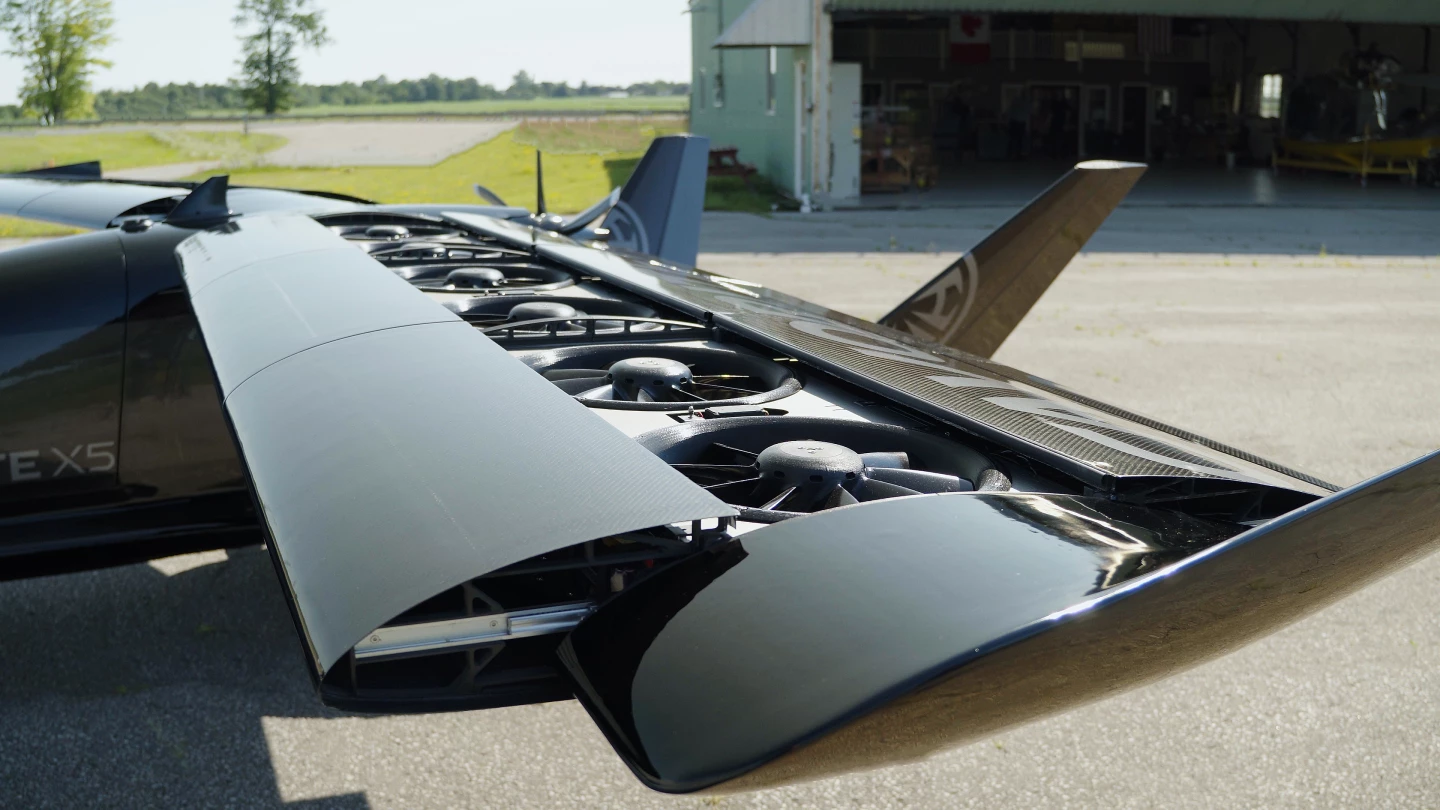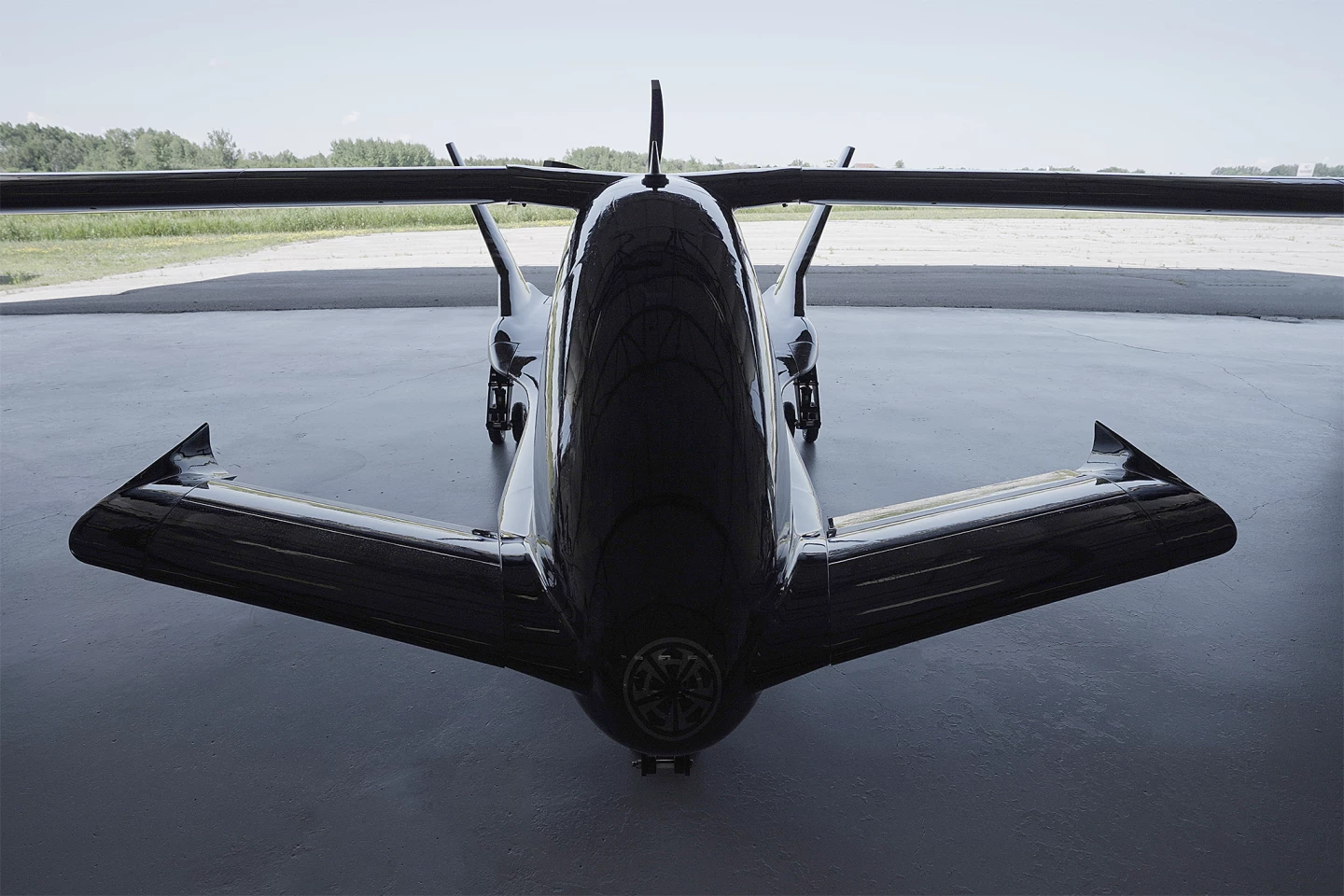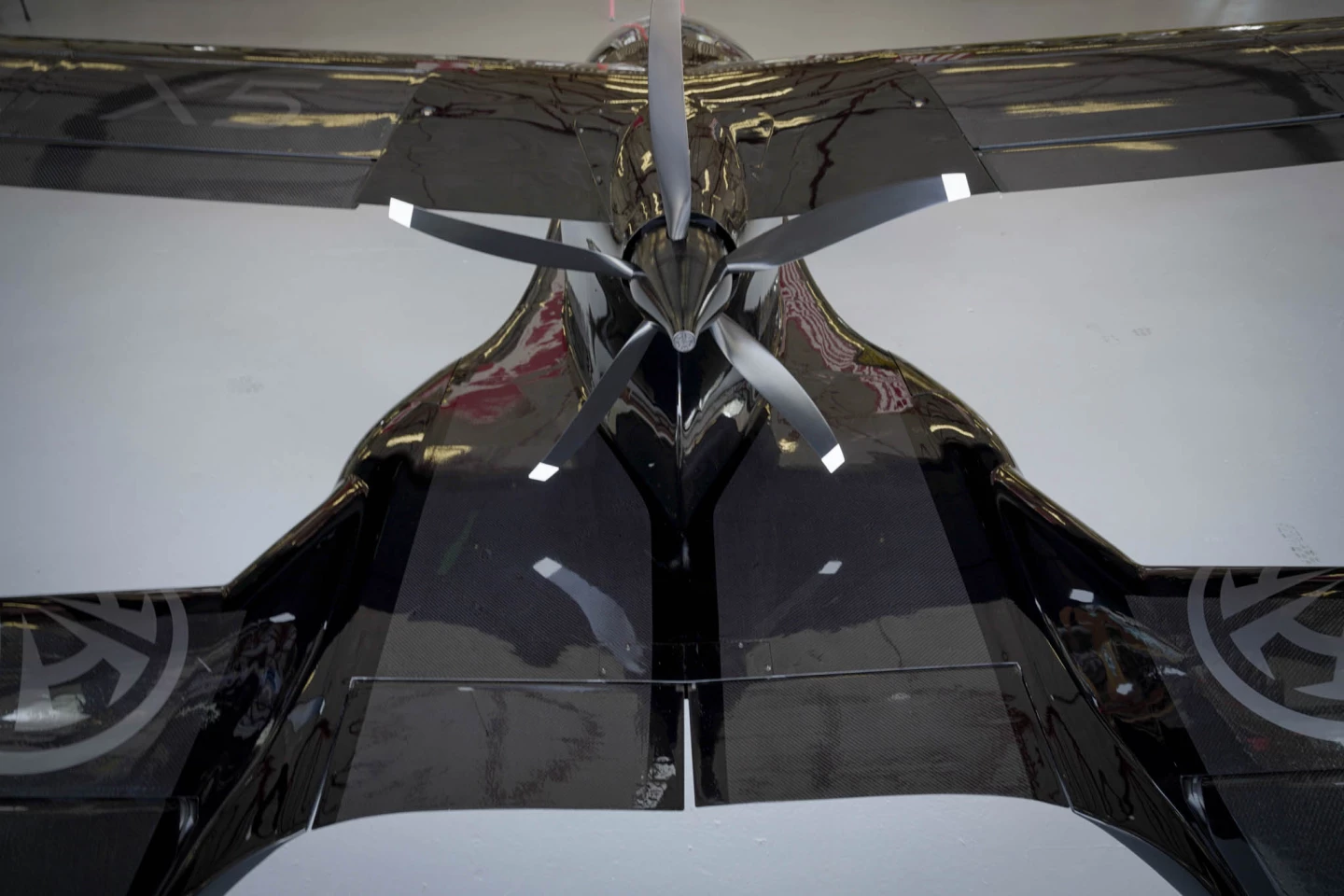Toronto's Horizon Aircraft has unveiled a 50% prototype of its gorgeous – and very unique – electric VTOL air taxi. The Cavorite X5 separates itself from the pack as the only eVTOL that completely covers its lift fans for super low-drag cruise flight.
With a wingspan of 22 ft (6.7 m) and a length around 15 ft (4.6 m), this half-scale prototype weighs 500-odd lb (~227 kg) – so it's by no means a small drone. We're pleasantly surprised to see this thing looking extremely close to the rendered designs we've seen for what has to be one of the best-looking aircraft in the eVTOL class – well, provided you can deal with the fact that it looks like it's made out of graphics cards.
The Cavorite X5 is a pure lift & cruise canard design, with 16 lift fans embedded in the wings and a single pusher prop at the back. Horizon has designed and patented a very neat wing design, in which the aerodynamic shell of a smooth, solid wing splits right down the middle. The leading and trailing edges of the wing move apart to reveal the lift fans for VTOL operations, then close and lock shut when it's time to cruise.
"You can think of the wing as a carbon fiber dual box beam structure," Horizon founder Brandon Robinson told us over a video chat. "That gives us enough space for the circular fans. The secret is to keep the system light enough, and still have a safe and robust opening and closing system. There's cross-talk between the wings to make sure the opening is symmetrical, and one won't keep opening if the other's jammed – and there's a pretty cool mechanism to drive those covers to a decent stop and lock them in place against buffeting. And we had to keep that whole system light, and elegant, and also ground repairable, because these things will be going to all sorts of crazy places."

The split-wing design solves a key problem with other lift & cruise designs with totally separate vertical and horizontal propulsion systems; the lift systems increase your drag in forward flight, limiting your top speed and chewing into your range figure. "At higher speeds it makes a huge difference, because the parasitic drag on any external fans, even if they're locked in place, is humungous," said Robinson. "Even a GPS antenna or a small pylon to carry something, at 200-plus knots (230 mph/370 km/h), they start to make a very, very significant difference."
As pretty much the only lift & cruise design that's made it to this stage with covered lift fans, the Cavorite X5 is able to promise a 240-knot (280 mph/450 km/h) max cruise speed, significantly faster than the Joby S4, which is currently the fastest eVTOL aircraft ever measured.
"It's difficult to get that speed out of a multi-rotor system, you have all kinds of flutter and aerodynamic issues, those aircraft are just not meant to go that quickly," said Robinson. "Even the V-22 Ospreys – when I flew F-18s, I planned and led personnel recovery missions in training, with about 100 jets airborne and a V-22 package going in to extract personnel in a downed pilot scenario. The V-22 is a multi-billion dollar program, one of the most advanced tilt-rotor systems on the planet. And they will still only typically fly in the 220-230 knot range."
"You know, it's funny," he continued. "We just participated in that Air Force HSVTOL contest, and there were some folks claiming they could go 465 knots (535 mph/860 km/h) true airspeed. I wonder if any of those folks have flown in a small aircraft at those speeds. Even the F-18s that I flew in the Air Force often aren’t happy going above 450 knots low level. We're just trying to be honest with folks, in the context of practical aviation experience."

So yes, in terms of flight dynamics, the Cavorite X5 will be about the closest thing in the eVTOL world to a regular fixed-wing plane, complete with rudders on the V-tails and control surfaces on the trailing edge of the canards and the wings. Robinson says the canard control surfaces may not be required at the end of the day, because of a split elevator system at the back of the plane that can help balance its pitch during transition to forward flight.
But either way, this machine is again one of few designs that can happily perform an energy-efficient conventional takeoff or landing where there's a runway available. And that could come in very handy given the small, relatively inefficient lift system this machine runs. "Everything is a compromise in aerospace, and we're not trying to sell the idea that this is a machine you'd want to sit and hover for 30 minutes," said Robinson. "It's a high disc-loading machine, it's power-hungry in its hover. That's the price you pay for that upper-end speed – but for 98% of the average mission, this aircraft is flying like a normal plane, with the added safety benefit that you can land it like a normal plane if anything goes wrong with the lift system."
There might also be a certification bonus here, too – theoretically, Horizon might be able to certify the Cavorite X5 as a fixed-wing plane to get it into service, then extend the certification to include VTOL operations at a later point.
The Cavorite X5 will be a hybrid aircraft, running an electric propulsion system powered by a combination of lithium batteries and some form of turbogenerator to allow range figures up to around 310 miles(500 km). "The power distribution system is probably more important than the actual generation capability," said Robinson. "It's not trivial to be able to charge the bus at the same time as drawing power from the batteries. And if we can use the turbo-gen to provide a percentage of the overall power required directly to the motors, then we can look at running smaller, lighter batteries."

Depending on exactly what mission the aircraft is being sold for, Robinson says the turbogenerator could run for the entire flight, or it could potentially power down into a "whisper mode" for quiet takeoffs and landings in urban areas or where some stealth is required. But the battery system would have to be designed to allow it.
Robinson told us this 50% scale prototype could fly tomorrow if they wanted it to, but they'll be taking flight tests slowly and carefully over the coming weeks and months. First will come ground work on a test stand, then tethered hover, then once permits are in place, untethered hover by sometime around the end of August. Then, the team will test it as a conventional fixed wing, before working on the tricky stuff around transitioning between hover and cruise modes.
The full-scale Cavorite X5, he says, it already in development, but the company will need to raise some Series A cash to get it built. And more again down the track for the expensive process of FAA certification, if it's to be sold as an air taxi. But that's not the only option. "We definitely have a 2025 goal in mind, and you always want to have a goal, just to drive the organization down a certain path," said Robinson. "But to be frank, there's a lot of nuance there, and any final dates I could give you on certification would be foolish. Do we sell it under the experimental category in the US first? It's not valid for commercial operations, but this could lead to significant early revenue."

"Or do we go the military route?" he continued. "The military has its own risk and certification framework. And the Air Force is certainly interested in this machine's ability to operate like a helicopter, but then fly twice as fast. There's a decent niche here for the military, if you scaled it up to an 8-12,000 lb (3,600-5,450 kg) aircraft that could carry a six- or eight-pack of fully equipped special forces guys in and out of a place. Or if you scaled it down to a potential unmanned system, either for attack or surveillance, but again with a good combination of speed, endurance and super-simple vertical takeoff and landing across a pretty broad range of weather conditions. A drone with its own launch and recovery system on board – that's pretty flexible."
There are exciting days ahead for the Horizon team in the coming months. This design genuinely stands out from the pack, offering some unique benefits as well as looking totally badass. We look forward to seeing this stunning prototype airborne, and wish the Horizon team every success in their upcoming funding round.
Source: Horizon Aircraft











